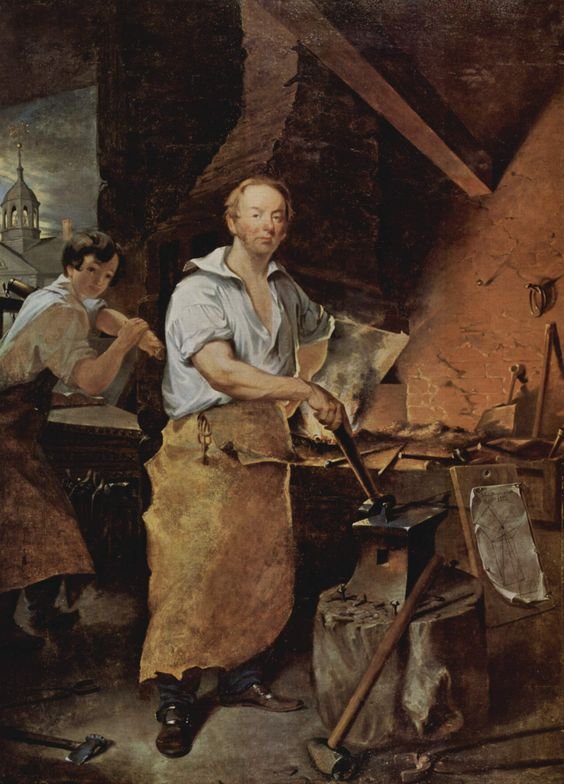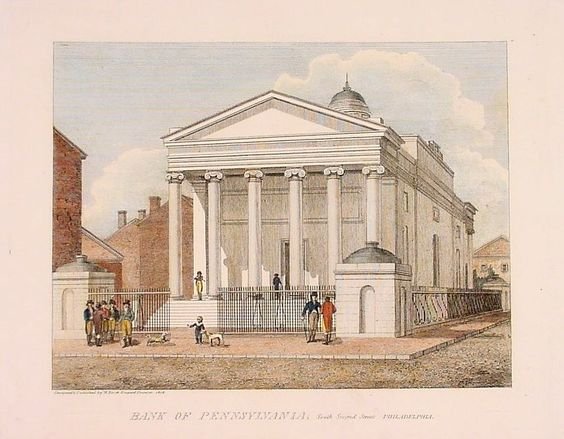The first Bank robbery in America
Take a look at this portrait, painted in 1829. Seems nothing unusual — many artists have devoted their works to the workers. But, as a rule, these paintings were a depiction of the harsh working life of working people, and in this case we see a formal portrait, made to order.The portrait depicts the most common blacksmith named Pat Lyon. So, what is he famous, and mostly, where did the blacksmith money, because at all times the order of a portrait from the artist — not cheap. No, he's not robbed a Bank, but had attitude, and even get rich on this.

It is no secret that robberies of banks in America has long acquired the status of a national sport. But when the same was committed the first Bank robbery in the US? It is easy to guess that the first one was robbed of one of the first banks established in the United States.
1781- the year of Foundation of the Bank of North America. Until 1783 he carried out the functions of the Central Bank. It kept the money Congress printed banknotes that were required to accept at face value all government agencies, and it was only at that time the Bank had the right to work in the country. In 1783 he received a commercial license and became the Bank of Pennsylvania.

Up to 1798 in the United States did not happened any Bank robbery. At the end of summer in Philadelphia an epidemic of yellow fever. Many left the city, fleeing from the raging disease. Others were forced to stay. About 1 300 people died quick, but horrible death.
One of those lucky enough to escape, Smith Patrick "Pat" Lyon. Along with his 19-year-old student he sat aboard a small sailing vessel and went on the road. However, by the time when they landed in Lewistown, Delaware, the young man was already sick. Two days later he died.
Pat Lyon was in despair, but soon an event occurred which altogether put him over the edge. To Lewistown has come the news that in the largest city of the country and financial center, in Philadelphia, from where he escaped Lyon, there was a robbery of the Bank of Pennsylvania. In the night from August 31 to September 1, 1798 from "carpenters Hall" of the Bank robbers made the huge sum of $ 162 821.
Pat Lyon was greatly interested in newspaper reports about the robbery. After all it it in a hurry before fleeing the city changed and adjusted the locks on the doors of a Bank vault. For Lyon, this meant not only a blow to professional pride, but also the threat of suspicion of involvement in the crime.
Anticipating possible questions of the police, Lyon began to scroll through the memory of the events of recent months. First of all, he came to the conclusion that it was an "inside job." The robbery took place quietly. The robber or robbers acted in secret, in an armed clash with the guards did not enter, and during the robbery no one was hurt. All this pointed to the fact that the criminals know the "internal kitchen" of the Bank, perhaps even participated in its construction or reconstruction.
Suspicion fell on Lyon carpenter, Samuel Robinson and his companion who came to his Studio with the support from the Bank of Pennsylvania. Robinson introduced himself to Smith as the foreman of carpenters, charged with work on the reconstruction Bank vaults. When Lyon agreed to cooperate, Robinson and his friend brought to the shop two iron doors and said that it is necessary to replace the fittings and locks. After inspecting the door, Lyon agreed that the locks really look grim for such a serious subject, and promised to put in door locks more complex designs.
Just now Pat Lyon reacted with the whole suspicion of these visitors and as buddy Robinson with interest delve into all the details of the production of locks and technologies that are used in this case Lyon.
Deciding not to wait for a visit from the police, the Lyon he went to Philadelphia, to Express their assumptions about the perpetrators of the robbery. But in the hometown of his revelations were skeptical. Constable John Haines immediately took him into custody, and when it turned out that in this same Bank was robbed at Lyon lies the contribution of $ 1 400, and he is the owner of his own shop, the suspicions only intensified. Although, frankly, this is odd when you consider that the Bank had stolen ten times more. However, the police had something to grab onto, and Pat Lyon was taken into custody. Bank officials and police were convinced that you had to deal with the locks on the doors of the money vault, Lyon produced for a extra set of keys. The Bank President and chief cashier together with the police also felt that the departure of Lyon to Delaware looks suspicious and mean, nothing like an escape with the loot. For the release of Pat Lyon at the period of investigation was appointed impossibly high bail in the amount of $ 150,000.
In prison was hard in Philadelphia continued to rage yellow fever, and prison was no exception. Lyon did not expect that I will be able to get out alive. He sat in the single size 2 x 4 ft, damp and cold, and most of the time provodil in prayer. Lyon remained nothing but to rely on good fortune or favorable circumstances. Before he had heard rumors on similar charges detained a few people. At least two Bank guards who also tried to associate with the theft. In the end, the fate, indeed, turned to face Lyon, but the subsequent events resembled a farce.
The investigation, in the end, confirmed the assumption of Lyon. As it turned out, he practically was not mistaken. Samuel Robinson was involved in the crime. Only he didn't act alone. Robinson was attracted to the plan of the robbery of his subordinate, a member of the Society of carpenters, Isaac Davis. Also the case involved a man from the Bank porter Thomas Cunningham, who on the night of the robbery were hiding in the Hall of the carpenters. Davis accompanied Robinson when they came to Lyon, he was the man who showed hot interest in the work of a blacksmith, and especially the castles, which he intended to put on the door of the vault cash.
A couple of carpenters, apparently, decided that came up with the perfect crime. Everything turned out as planned, however, Samuel Robinson, died of yellow fever a few days after the robbery. But the rest of the criminals have committed the classic mistake of Bank robbers — they have to spend their money. Unbridled spending has not escaped the attention of the police for which the disclosure of the theft was the primary cause.
Immediately after his arrest, Davis confessed and made a deal with the investigation. The Governor of Pennsylvania has agreed to a pardon in exchange for that, Davis will return all the money, and also will tell about the robbery all that he knew, so it helped strengthen the security of American banks.
What Pet lion? Surprisingly, the robber Davis not a day spent in prison, and the innocent lion had continued to languish in prison. Moreover, when the robbers were already caught, some police continued to insist that Smith was privy to the plan and participated in it. He allegedly has produced a set of keys to vault cash. Another few weeks he continued to sit, until I finally was acquitted.
Coming to freedom, slandered and insulted Pat Lyon, decided that it would be fair if he will receive compensation for their suffering. First, less than a year after his release from prison, he published a book about the case, and secondly, filed a lawsuit against the Bank of Pennsylvania and the law enforcement agencies of the state.
In 1805 the leading lawyers of the time were ready to fight each other to participate in a high profile case. Civil action Lyon was addressed to the President of the Bank of Pennsylvania Samuel M. Fox, the head of cash services Jonathan Smith, a member of the Board of Directors John Clement Stocker and constable John Haines. The interests of both sides defended well-known lawyers. On the side of the defendants were Jared Ingersoll, a Philadelphia lawyer who was a delegate to the Second Continental Congress, a signatory of the U.S. Constitution from Pennsylvania. Until 1799, and then from 1811 to 1817 he served as state attorney General.
In the courtroom were about two dozen witnesses. Defence lawyers have seen the only viable option in this situation is proof of the absence of malicious intent in holding the plaintiff in custody.
After a four-hour meeting, the jury returned with a verdict in favor of Pat Lyon. The government together with the Bank of Pennsylvania have agreed to pay Lyon $ 12 000. Two years thereafter, the defendants appealed, but what they managed to achieve is to reduce the amount to $ 9 000. This final decision was made by the court in March, 1807. Given the revenue per book sold at $ 2 000, Pat Lyon received a very substantial sum, allowing him to live out his days in financial comfort. Saying he became a successful manufacturer of steam fire engines.
The following documented robbery of the American Bank held only in 1831. It also happens quietly and without bloodshed. After that will come the long break, after which, in 1863, happens a real armed robbery. While it already people will die, and from that moment will begin a series of Bank robberies continuing to this day.